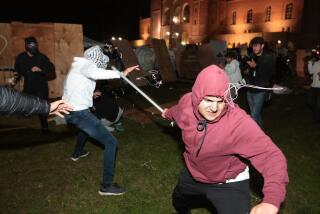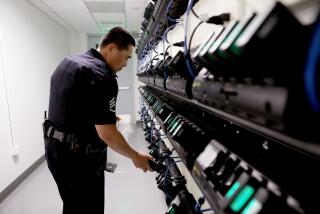Enhancement of Riot Tapes Explained : Denny case: Expert tells jury that computerized process was used to highlight details and trace them to one person. Prosecution maintains that that man is Damian Williams.
High-tech image processing moved to the forefront of the Reginald O. Denny beating trial Friday as prosecutors sought to connect physical details culled from various videotapes and establish that they are connected to one defendant--Damian Monroe Williams.
Leonid I. Rudin, director of Cognitech in Santa Monica, explained how his firm enhanced images of a stain, a spray-paint can, a facial blemish and clothing, tracked them through separate videotape segments and tied them to one man.
Prosecutors maintain that man is Williams, who they say is shown on videotape wearing a white T-shirt, knee-length dark shorts, a pair of black and white Nike sneakers and a blue bandanna at Florence and Normandie avenues as rioting broke out last year.
Cognitech’s computer-enhanced images amount to a chain of connected details, prosecutors say. A close-up shot shows a man with a facial blemish dressed in a white T-shirt and blue bandanna. Another segment shows the blemish, shirt and bandanna, but now the black and white shoes are visible. In that segment, the shirt is shown to have a stain.
Then the elements are a T-shirt with a stain, bandanna, shoes and shorts; another videotape segment includes that clothing and introduces a spray-paint can held in one hand. That can is tracked to a shot showing only the sneakers and an outstretched hand using the can to spray-paint an unconscious victim.
Answering questions from Edi M.O. Faal, Williams’ attorney, Rudin said he had enhanced images from several assaults, but none from the attack on Denny.
Faal contends that the attack on Denny was not enhanced because there is no stain on the white T-shirt worn by the man who hit the trucker in the head with a brick.
“The Denny (beating) tape was not enhanced because it would have exculpated Mr. Williams,” Faal said outside court.
Deputy Dist. Atty. Janet Moore flatly rejected that assertion, saying outside court that prosecutors saw no need to enhance the Denny beating when they had witnesses who identified Williams as the assailant.
“Why would we want to spend time on the Denny segment with all the other evidence we have?” she asked. She added that the absence of a stain is not a concern to the prosecution. Earlier this week she said it was reasonable to assume that Williams walked home--less than five minutes away--and changed shirts.
Faal responded sarcastically: “Yes, in the middle of a riot you take time to go home, freshen up and change shirts.”
Several Los Angeles police officers who investigated crimes committed during the riots also testified Friday. The detective who once headed the investigation of the Denny beating said he was told that Williams was the assailant two or three days later.
Detective Thomas J. Sokarda said another officer identified Williams from a newspaper photo, and investigators had the suspect’s home address. But Sokarda did not arrest Williams. He said the situation at the 77th Street Division where he worked was too hectic, and the civil unrest was still raging.
Williams’ highly publicized arrest did not come until May 12, 1992, two weeks after the attack on Denny.
Former Hawthorne Police Sgt. Don Jackson, a spokesman for the Williams family, said he found it incredible that police officers would “excuse not apprehending a suspect.”
More to Read
Sign up for Essential California
The most important California stories and recommendations in your inbox every morning.
You may occasionally receive promotional content from the Los Angeles Times.










